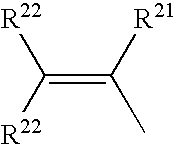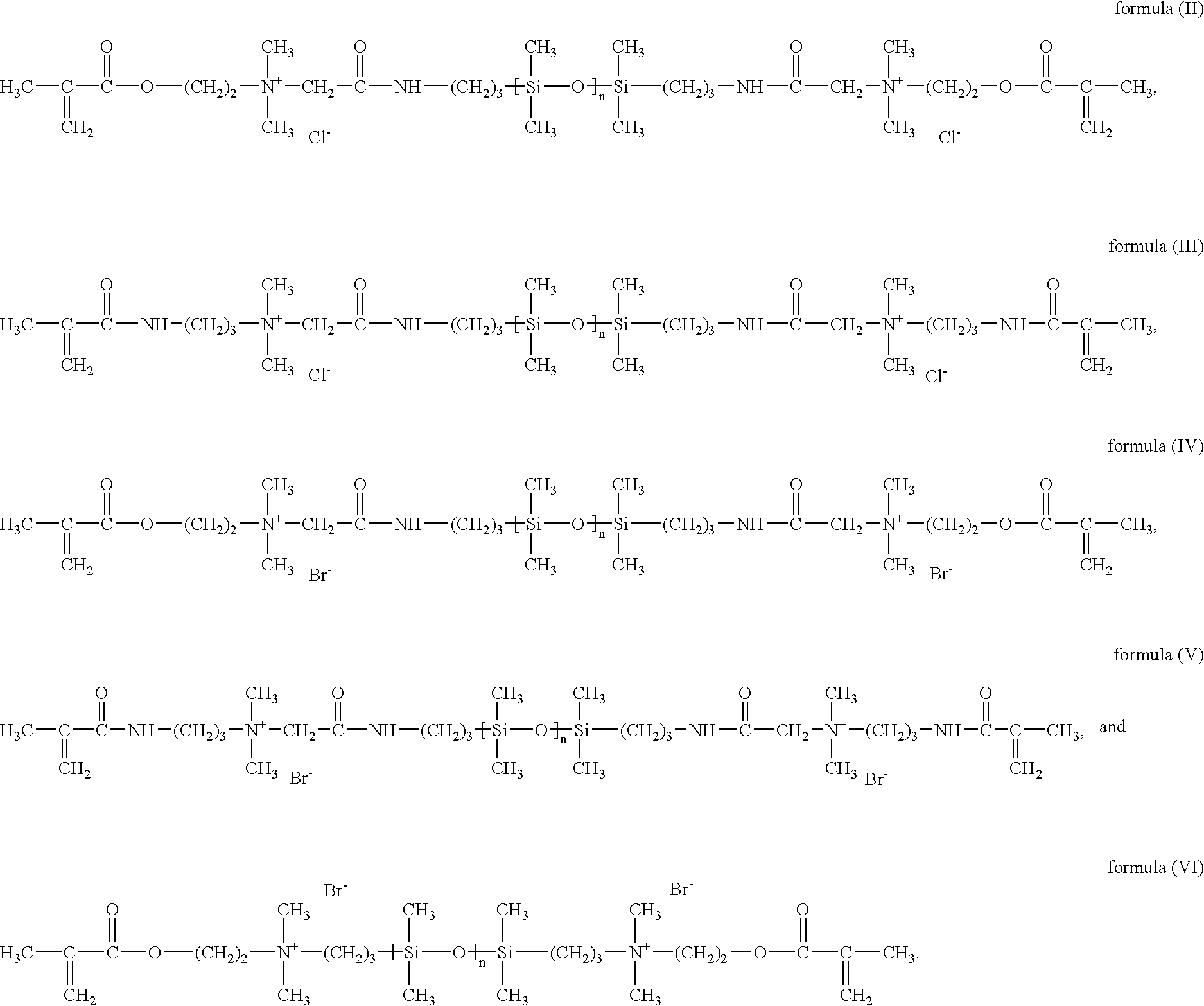Silicon-containing monomers end-capped with polymerizable cationic hydrophilic groups
a technology of cationic hydrophilic groups and monomers, which is applied in the field of polymer compositions, can solve the problems of difficult copolymerization and processing using standard hydrogel techniques, poor water soluble ability, etc., and achieves desirable biocompatibility and comfort, high oxygen permeability, and high oxygen permeability.
- Summary
- Abstract
- Description
- Claims
- Application Information
AI Technical Summary
Benefits of technology
Problems solved by technology
Method used
Image
Examples
example 1
Synthesis of 3-(chloroacetylamido)propyl Terminated poly(dimethylsiloxane)
[0078] To a vigorously stirred biphasic mixture of a solution of 3-aminopropyl terminated poly(dimethylsiloxane) (97.7 g, 3000 g / mol) obtained from Gelest, Inc., Morrisville, Pa. in dichloromethane (350 mL) and NaOH (aq) (0.75 M, 150 mL) at 0° C. was added a solution of chloroacetyl chloride (8 mL, 0.1 mol) in dichloromethane (50 mL) dropwise. Following an additional 1 hour at ambient temperature, the organic layer was separated and stirred 5 hours over silica gel (25 g) and Na2SO4 (25 g) and filtered. Solvents were removed at reduced pressure to afford the product as a colorless liquid (85 g, 83%): 1H NMR (CDCl3, 400 MHz) δ 6.64 (br, 2 H), 4.05 (s, 4 H), 3.29 (q, J=7 Hz, 4 H), 1.60-1.52 (m, 4 H), 0.56-0.52 (m, 4 H), 0.06 (s, approximately 264 H); GPC: Mw 3075 g / mol, PD 1.80. The mass spectrum of this sample indicated a mass distribution of singly charged oligomers having a repeat unit mass of 74 Da. This cor...
example 2
Synthesis of 3-(bromoacetylamido)propyl terminated poly(dimethylsiloxane)
[0079] Aminopropyl terminated poly(dimethylsiloxane) (50.2 g, 3000 g / mol) was reacted with bromoacetyl chloride in substantially the same manner as described in the example 1 to afford the product as a viscous, colorless oil (40 g, 74%): 1H NMR (CDCl3, 400 MHz) δ 6.55 (br, 2 H), 3.89 (s, 4 H), 3.27 (q, J=7 Hz, 4 H), 1.60-1.52 (m, 4 H), 0.54 (t, J=7 Hz, 4 H), 0.06 (s, approximately 348 H). GPC: Mw 5762 g / mol, PD 1.77. The mass spectrum of this sample indicated a mass distribution of singly charged oligomers having a repeat unit mass of 74 Da. This corresponds to the targeted dimethyl siloxane (C2H6SiO) repeat unit chemistry. The targeted end group nominal mass for this sample is 414 Da (C12H24N2O2SiBr2) and the required sodium charge agent has a mass of 23 Da (Na). The mass peaks in the distribution for this sample correspond to a nominal mass sequence of (7433 n+414+23) where n is the number of repeat units. T...
example 3
Synthesis of cationic methacrylate chloride terminated poly(dimethylsiloxane)
[0080] To a solution of 3-(chloroacetylamido)propyl end-capped poly(dimethylsiloxane) (19.96 g) from example 1 in ethyl acetate (25 mL) was added 2-(dimethylamino)ethyl methacrylate (3.40 mL, 20.1 mmol) and the mixture was heated 39 hours at 60° C. under a nitrogen atmosphere in the dark. The resulting solution was stripped of solvent and / or reagent at reduced pressure affording the product (23.1 g) containing a residual amount of 2-(dimethylamino)ethyl methacrylate (1H NMR analysis: 1H NMR (CDCl3, 400 MHz) δ 9.23 (br, 2 H), 6.07 (s, 2 H), 5.60 (s, 2 H), 4.71 (s, 4 H), 4.65-4.63 (m, 4 H), 4.18 (br, 4 H)3.47 (s, 12 H), 3.19-3.13 (m, 4 H), 1.88 (s, 6 H), 1.53-1.49 (m, 4 H), 0.51-0.47 (m, 4 H), 0.01 (s, approximately 327 H). The mass spectrum of this sample indicated a mass distribution of doubly charged oligomers having a repeat unit mass of 37 Da. When deconvoluted this corresponds to a repeat unit mass of ...
PUM
| Property | Measurement | Unit |
|---|---|---|
| Time | aaaaa | aaaaa |
| Dimensionless property | aaaaa | aaaaa |
| Dimensionless property | aaaaa | aaaaa |
Abstract
Description
Claims
Application Information
 Login to View More
Login to View More - R&D
- Intellectual Property
- Life Sciences
- Materials
- Tech Scout
- Unparalleled Data Quality
- Higher Quality Content
- 60% Fewer Hallucinations
Browse by: Latest US Patents, China's latest patents, Technical Efficacy Thesaurus, Application Domain, Technology Topic, Popular Technical Reports.
© 2025 PatSnap. All rights reserved.Legal|Privacy policy|Modern Slavery Act Transparency Statement|Sitemap|About US| Contact US: help@patsnap.com



